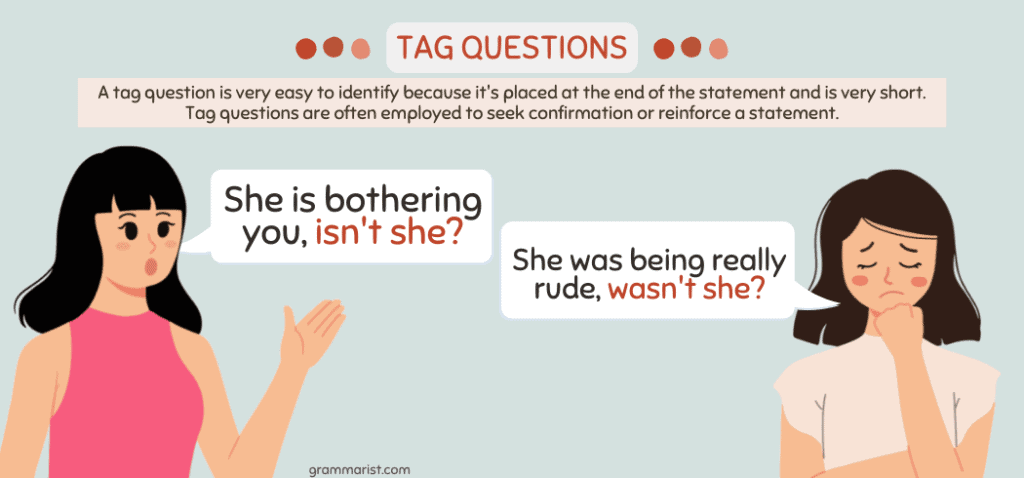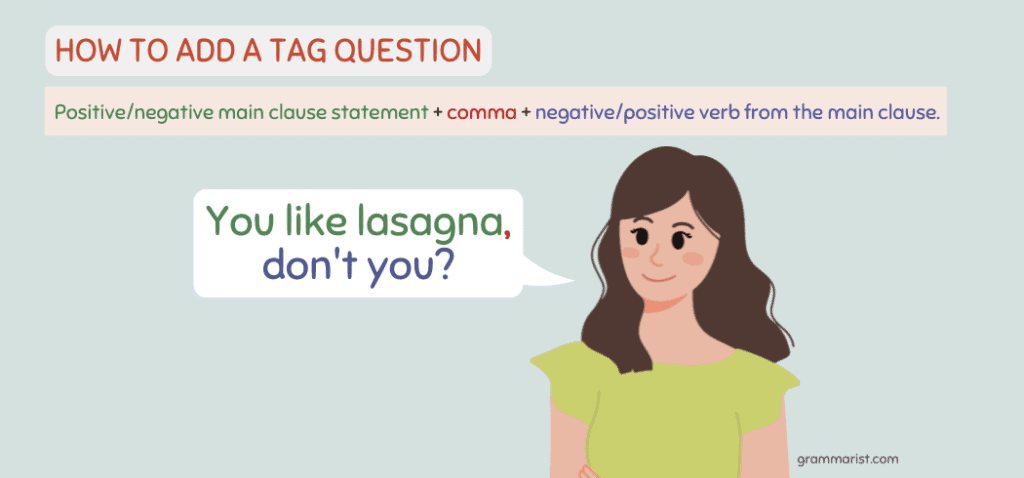Do you know how to use tag questions? You might be surprised at how common they are in daily conversation. You probably already use them. My guide is sure to teach you all about tag questions, including their uses and examples.
Plus, I’ve even provided a handy worksheet to help you practice using them yourself. Let’s get started!
What Is a Question Tag?

A tag question is very easy to identify because it’s placed at the end of the statement and is very short. Tag questions are often employed to seek confirmation or reinforce a statement. We use positive tag questions with negative statements and vice-versa.
You’ll find them as a short phrase that typically appears at the end of a sentence. It makes a statement sound more interrogative by adding a questioning element to it. There are many different types of question tags, which can be used to communicate various meanings and feelings.
For example, an expression like “you wouldn’t believe how well my dog is doing” might be followed by a positive-sounding question tag such as “would you?”
Alternatively, an assertion such as “she is bothering you” could be followed with a negative or uncertain-sounding question tag such as “isn’t she?”
In addition to their grammatical function, question tags can also help to convey the speaker’s attitude or tone of voice. Whether they express surprise, doubt, or disbelief, question tags enable us to add extra nuance and feeling to our statements and questions.
How to Answer Tag Questions
Tag questions can usually be replied to with a direct answer of “yes” or “no.”
When offering a simple answer, know that negative tag questions usually expect a positive answer, while positive tag questions imply that the person is expecting a negative answer. You can also answer by adding an auxiliary verb after “yes” or “no.”
Let’s look at some examples with a correct answer:
- You took the car keys last night, didn’t you? Yes, I did.
- I’m not being intrusive by asking all these questions, am I? No, you’re not.
Question Tag Rules
When forming tag questions, there are a few simple rules to remember.
The first rule is always to have an identical subject for the tag question and the original statement.
For example:
- Correct: I am not imposing, am I? – Notice how “I” is the same subject used in both constructions.
- Incorrect: You didn’t listen to a word I said, did I? (It should be “did you?”)
The second rule is to have the verb in the statement match the verb in the tag. Both verbs must have the same tense.
Examples:
- You have been feeling better these past few days, haven’t you?
- Sarah can’t afford to pay rent if she loses her job, can she?
The third rule to keep in mind is to always use a positive tag question with a negative statement (and vice-versa).
Examples:
- Correct: John has been studying really hard for this exam, hasn’t he?
- Incorrect: John has been studying really hard for this exam, has he?
- Correct: Tina didn’t miss a single school day this year, did she?
- Incorrect: Tina didn’t miss a single school day this year, didn’t she?
Common Tag Questions
Here are some more question tag examples:
- You’re not used to cold temperatures, are you?
- Gabriel can speak Spanish fluently, can’t he?
- I don’t talk too loud, do I?
Why Do We Use Question Tags?
The use of question tags is a common feature of many different languages and dialects. Question tags are short phrases or words that follow a declarative statement and function to reflect the speaker’s attitude or level of certainty about the statement.
In English, for example, question tags might include “isn’t it?”, “aren’t they?”, or “didn’t we?”. There are several reasons these types of questions are used, such as to express uncertainty, check listener comprehension, or sharpen an affirmative statement.
Question tags can also increase verbal fluency and help listeners engage more actively with the speaker’s message. The purpose of question tags is to facilitate communication and help people to share their thoughts and opinions clearly and effectively.
How Do I Add a Tag Question?

To add a tag question, you need to start with an affirmation in the main clause. Add a comma at the end of that affirmation and use the verb’s reverse form (negative or positive) in the main clause.
The most straightforward formula is positive/negative main clause statement + comma + negative/positive verb from the main clause.
Examples:
- You like lasagna, don’t you?
- Nancy is Dwight’s first cousin, isn’t he?
- Bob doesn’t like going to parties, does he?
How Do You Identify a Tag Question?
A tag question is a short sentence or phrase at the end of another sentence that expresses doubt or uncertainty. To identify a tag question, you need to look for these particular words and examine whether the rest of the sentence has a different level of certainty than what is expressed at the end.
For example, consider the following sentence: “He’s never in on time, is he?”
The statement “is he” is a tag question because it expresses uncertainty about whether or not its main point – that he’s late all the time – is valid.
Other clues that you might be looking at a tag question include statements like “aren’t I” and structures such as imperatives followed by an explicit question like “aren’t we” or “shouldn’t we.”
Positive Sentences with Tag Questions
Positive tag question endings are a type of grammatical construction in which a clause or sentence is followed by a question that reinforces or contradicts the original idea. This type of tag question can be quite effective, allowing speakers to quickly test their ideas and adapt their wording to communicate effectively.
Because positive statement tag questions require speakers to make declarative statements followed by a direct inquiry, they are usually used when asking for confirmation or verification of information.
Examples of positive sentences with question tags:
- Mother is always right, isn’t she?
- You will help me finish my essay, won’t you?
Negative Sentences with Tag Questions
Negative question tags are a common feature of everyday speech, used to express doubt or uncertainty about a particular statement.
For example, you might say, “they aren’t happy with the current situation, are they?” when expressing your own skepticism about a decision that has just been made. Using the word aren’t makes the statement negative.
While negative statement tag questions can help us to appear more forthcoming and engaging in conversations, research suggests that they can also be perceived as dismissive or judgmental if used too frequently.
Final Thoughts
A tag question is a short, grammatical unit used to express uncertainty or ask for confirmation. Typically, it consists of a statement followed by what appears to be a question. In reality, however, this “question” part states what is already implied in the original statement. Tag questions can also be used to convey politeness or modesty. I hope this helped you better understand them!